| Predicting the Future - it is(n't) written in the stars |
|
The sun rises and the sun sets, and hurries back to where it rises. The wind blows to the south and turns to the north; round and round it goes, ever returning on its course. All streams flow into the sea, yet the sea is never full. To the place the streams come from, there they return again. Ecclesiastes, 300BC |
 |
 |
To
be able to make any plans in your life, it is useful to know what might
happen in the future. Nowadays, we can assume certain things are likely
to happen - passing exams will probably lead to a job, income, and then
more exams. In ancient times we wanted to know long a year was likely
to be, when to plant crops, when to gather the harvest, and when we
were past the middle of the winter.
|
Thus the geometric positions of the Earth as it orbits around the Sun were marked by the year's religious festivals, and although we commonly think of 'time' as a straight line going ever forward into the unknown, it is an interesting exercise to mark the year out as a circle:
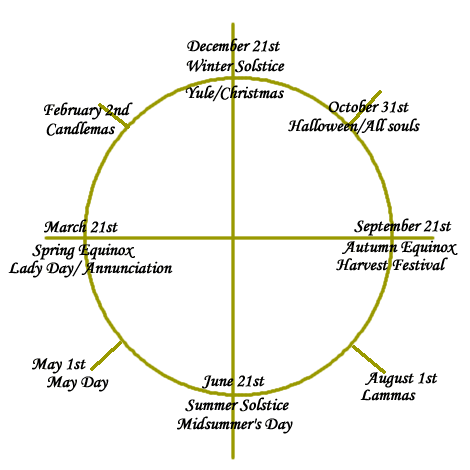
 |
In
45BC, Julius Caesar (with a little help from Sosigenes)
designed the modern European calendar, with the same number of days
and months, starting on the 1st January. The Spring Equinox was fixed
on the 25th March, but due to inaccuracies in the leap year system,
by the time of the Council
of Nicea in 325 AD, the equinox, important for calculating when
Easter occured, had shifted back to the 21st March, where it was deemed
fixed.
|
|
The ecclesiastical rules are:
|
 |
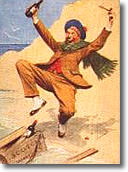 |
The 25th March was adopted by England as the legal and tax year end in the twelfth century, and it was only in 1752, when the equinox had shifted back to the 10th March, that Britain changed from the Julian to the Gregorian calendar, and we had to readjust this date. Before 1752, it was possible for a baby to be born in March, and die in February the same year. With the loss of 11 days, the 25th March became 5th April - which until recently was our end of the Tax year. At the same time we decided to revert to 1st January as our New Year's Day, although Scotland had done so in 1600 - perhaps that's why they celebrate Hogmanay so much. |
|
Confusing, isn't it? This is probably also the reason that we celebrate our midwinter festival on the 25th December, not the 20th/21st when the Winter Solstice occurs. |
 |
| Astrology |
 |
At
a time when the true nature of stars and planets was obscure, it was
possible to believe that the only way that the planets moved was magical
and divine. People tended to look for meanings in the various positions
of the things in the sky, and they tried to tie in times of the year
with happenings in the heavens, making themselves believe that the stars/planets/sun/comets
could influence people on earth.
|
|
Of
course, one way that seasonal variations could possibly influence somebody,
would be to change what their mother was eating whilst they were in
her womb. So perhaps if you were pregnant during the winter when there
wasn't much fresh veg, you might have a child with different characteristics
than if the pregnancy occured in the summer, with loads of fruit in
the diet. Or perhaps the amount of daylight or warmth would influence
maternal hormones of pregnancy.
|
 |
Anyway, as mentioned before, the Sun and planets appear to take a particular path across the background of the fixed stars, due to the angle of rotation of the Earth, and its orbit around the Sun. This line is called the ECLIPTIC, and it passes through about 12 constellations (actually 13). The band 6 degrees either side of the ecliptic is called the Zodiac.
 |
A
long time ago, the Babylonians (Northern Iranians to you and me), marked
out the year according to which constellation the sun appeared to be
moving through, starting the year at the Spring Equinox (now March 20th
or 21st). Here is a schematic diagram, showing the signs of the zodiac,
with approximate dates.
|

The constellation that contained the Spring Equinox, when the sun leaves the dark half of the year, and enters the light half of the year, was always thought to be the dominant celestial entity.
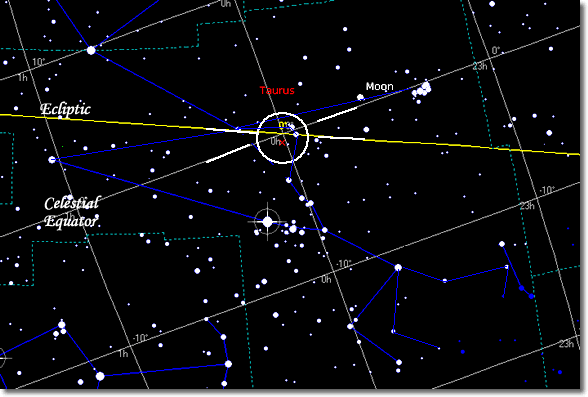 |
|
Between
4200 B.C. to 2000 B.C the Spring (vernal) Equinox (circled in white)
occured when the Sun seemed to be passing through Taurus
the Bull.
|
 |
Some people think that is why the mediterranean peoples worship the
Bull, including the sacred cows of the Hindus.
|
 |
|
The Egyptians worshipped Apis, the god bull - seen here with the sun resting in its horns. This is the chap that Moses caught his people worshipping when he came down from Mount Zion with the Ten Commandments. He wasn't very happy, and killed quite a few of his uncles, aunts and cousins. Nasty temper, old Moses. |
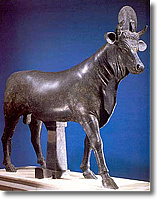 |
 |
|
Here
is Fillipo Lippi's picture of the bull worshippers. The bull has the
crescent moon emblazoned on its shoulder.
|
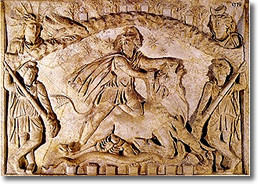 |
It
was found that over time, the Vernal Equinox changes constellation.
The time when Taurus was 'defeated' as the dominant constellation seems
to be repeated in Mithraism,
a religion common in the Roman Army, and related to Zoroastrianism.
|
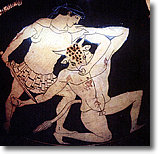 |
We
also have the myths of
Theseus slaying the Minotaur on Crete, and it is commemorated in
ritual bull fighting.
|
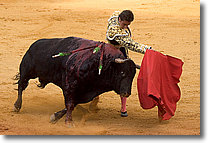 |

|
Between 2000BC and 7BC, the constellation of the vernal equinox was Aries, and the point where the Ecliptic crosses the Celestial Equator is still known as the First Point of Aries. Here is a sacrificial Ram - ready for Abraham. |
 |
 |
However,
due to the Precession
of the Equinoxes, the actual constellation in which
this point occurs, has been
Pisces for the
last 2000 years
|

This is the appearance of the sky between June and December, 7BC. You can see that the Vernal Equinox (ringed white - the Ecliptic is yellow) has just moved into the constellation Pisces, and that there also is a conjunction of Saturn and Jupiter in that constellation. These conjunctions happen around the zodiac every twenty years, but for it to occur in the constellation of the vernal equinox is very rare. This would have set the world alight, and astrologers everywhere would be predicting a great event.
|
Undoubtedly the Three Wise Men were Persian (Parsee - from northern Iran) astrologers who noted a particular celestial event, possibly this conjunction, and journeyed to Palestine to look for the new king. This is certainly one explanation of the Star of Bethlehem. In about 600 years, the vernal equinox will be in the constellation of Aquarius. |
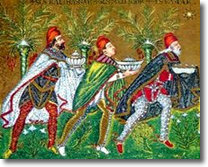 |
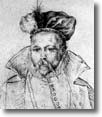 |
Tyge
Brahe was employed mainly as a court Astrologer - paid to predict
good and bad days for his employer to do things, e.g. start a war etc,
depending on where the planets were in the sky.
|
|
When
Halley's
comet was seen at Harold
Godwinson's coronation in 1066, it was taken as a bad omen. It was
certainly bad for King Harold, who ended up dead within nine months.
|
 |
But as we learned more about what we could see in the sky, it turned out that the heavenly bodies were no more able to help us predict the future than the insides of chickens, tea leaves, or tarot cards, which is a bit disappointing, as we now have to take responsiblity for our own actions, whilst realising that God/fate will undoubtedly have a part to play in the eventual outcome. And the Sun will come out tomorrow. Probably.
-------------------------------